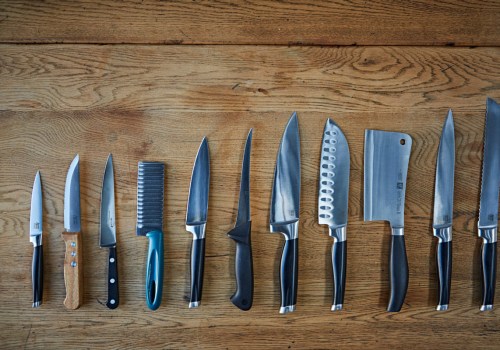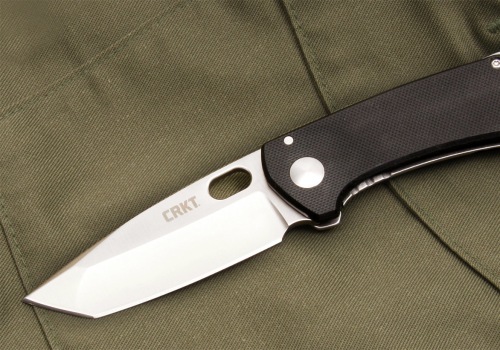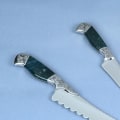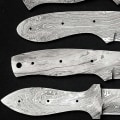Crafting a handmade knife is an incredibly rewarding experience that requires the right tools and equipment. From the steel of the blade to the handle material, every decision will affect the quality of the final product. One of the most important pieces of equipment for knife makers is drills and bits, which are used to create holes in the handle material for screws, lanyards, and other hardware. To ensure that knife makers get the best tools for the job, it's important to understand the different types of drills and bits available and their respective purposes.
In this article, we'll explore the various drills and bits available for knife handle fabrication, as well as how to choose the right ones for your needs. When selecting a drill and bit for your knife handle, there are several factors to consider. The type of material you are working with is an important factor, as different materials require different types of drills and bits. For example, softer materials like wood or plastic require a smaller drill bit than harder materials like steel. Additionally, the size of the drill bit should be based on the size of the handle you are creating.
It's also important to consider the type of drill you will be using. For most knife handles, a hand drill is ideal as it gives you more control over the drilling process. If you are using a power drill, there are many different types to choose from. Make sure to research each type to determine which one is best suited for your needs. Once you have chosen the right drill and bit for your handle, it's time to get started! Here are some tips to help you create a successful knife handle:
- Start by marking where you want the hole to be drilled.
- Secure the handle in a vise before drilling so it won't slip or move while drilling.
- Use a center punch to create a starting point for your drill bit.
- When drilling, make sure to use slow, steady movements in order to avoid any damage or splintering of the material.
- Once the hole is drilled, use sandpaper or a file to smooth out any rough edges or burrs.
- Finally, apply an appropriate finish such as paint or varnish to protect the handle and make it look great!
Make sure that you clean your drill and bit after each use in order to keep them in good condition and extend their lifespan. Additionally, store them properly when not in use by wrapping them in a cloth or placing them in a toolbox. Finally, always wear safety equipment such as goggles and gloves when working with drills and bits to ensure your safety.
Maintaining Your Drill and Bit
Maintaining your drill and bit is essential in order to keep them in good condition and extend their lifespan. Cleaning your drill and bit after each use is the best way to ensure that they are working properly and will last for a long time.Additionally, proper storage of your drill and bits when not in use is important to prevent rust or other wear. To clean your drill and bits, you can use a mild soap and water solution. Be sure to get into all the nooks and crannies, as well as the shafts and threads, to remove any excess dirt or debris. After cleaning, you should use a soft cloth to dry your drill and bits completely. When it comes to storage, it is important to keep your drill and bits in a cool, dry place. Additionally, you should store them in a box or container that is designed specifically for tools.
This will help protect them from dirt, dust, and debris. By taking the necessary steps to maintain your drill and bits, you can ensure that they will last for many years. Clean them regularly, store them in a safe place, and you should be able to enjoy the benefits of having quality tools for many years to come.
Drilling Tips
When it comes to creating a handmade knife, having the right drill and bit are essential tools for a successful knife handle. Here are some tips to help you create a strong, durable, and comfortable handle:Start by marking where you want the hole to be drilled: Before drilling, it is important to take measurements and mark where the hole should be drilled. This will help ensure that your hole is in the correct place and of the desired size.Secure the handle in a vise before drilling: Securing your knife handle in a vise before drilling will help keep it steady and prevent it from slipping during the drilling process.
Use a center punch: A center punch is a tool that is used to make an indentation on the surface of your handle.
This will help ensure that your drill bit doesn't slip or wander while drilling.
Drill slowly: Always drill slowly when working with a knife handle. If you drill too quickly, you may end up with a hole that is too big or jagged edges.
Sand any rough edges: After drilling, sand any rough edges to give your handle a smooth finish.
Apply a finish: Once the hole is drilled and the rough edges have been sanded, apply a finish to protect your knife handle from wear and tear. This can include oil, wax, lacquer, or paint.
Choosing the Right Drill and Bit
When selecting a drill and bit for your knife handle, there are several factors to consider including the type of material you are working with and the size of the drill bit.The type of material you are working with will determine the type of drill bit you need. For example, if you are working with steel or titanium, then you will need a high-speed steel (HSS) or cobalt drill bit. If you are working with wood, then you will want to use a spade bit or a self-feed bit. Additionally, the size of the drill bit should be appropriate for the size of the handle you are making.
A larger bit is better for larger handles while a smaller bit is better for smaller handles. It's important to select a drill and bit that is up to the job. You don't want to use a dull or worn-out bit as this will make your work more difficult and could cause damage to the material or the finished handle. Additionally, you want to make sure you have the right speed and torque settings on your drill so that it can do its job efficiently and safely. It's also important to note that some materials require special bits. For example, if you are working with titanium or ceramic, then you will need diamond-coated bits as these materials are particularly hard and require special tools.
Additionally, when drilling into stainless steel, you may need to use an oil lubricant to prevent overheating. Finally, when selecting a drill and bit for your knife handle, be sure to double-check your measurements and ensure that the hole size is correct before drilling. This will help prevent any mistakes that could be costly in terms of time and money. Drills and bits are essential tools for creating a successful knife handle. By selecting the right drill and bit for your project, drilling with care, and maintaining your tools properly, you can ensure that your knife handles will be strong, durable, and look great! Whether you're a professional or just starting out in knife making, having the right drill and bit will help you create a quality piece that will last. With the right knowledge and tools, you can create a beautiful and durable handle for any knife.







Leave Reply